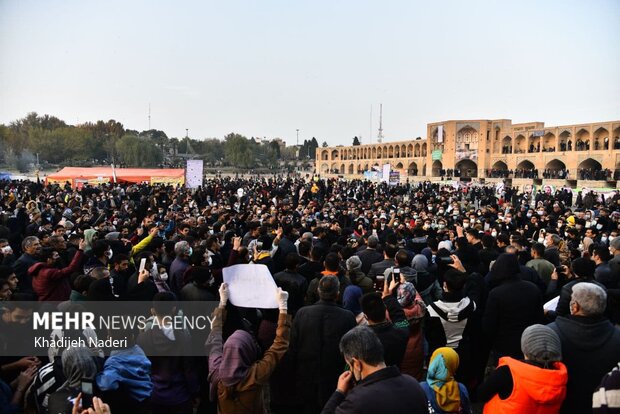For over two weeks last month, farmers and their families protested over the severe water shortage as they marched across the dry riverbed of the Zayandeh Rud River (the life-giver river) in the city of Isfahan, Iran. On the 19th of November, more citizens joined these peaceful protests in solidarity with the farmers. Reports say it was the most extensive environmental protest in Iranian history, with thousands of people present. The protests soon became violent, however, resulting in 67 reported arrests and several wounded followed by more violent protests over the next few days.
The Complex Geopolitics of Water in Iran
Yet, this was not the first time farmers protested against Isfahan’s water shortage, nor is the water shortage unique to Isfahan. Following the protests, the country’s vice president, Mohamad Mokhber, gave a brief statement to state TV where he promised that they were “seriously trying to solve the water problem … especially for Isfahan.”


According to the Islamic Republic of Iran Meteorological Organization, an estimated 97% of the country now faces some level of drought, which emphasises the imminent water bankruptcy Iran is facing.
Iran’s geography is diverse; while the country has two noticeable deserts in the central east, the Zagros mountains in the west are the source of many rivers which flow into southwestern and central parts of the country. Zayandeh Rud, whose now dry riverbed was marched over by protesters, is one of these rivers, and the reason for the initial creation of the city. The farming areas of Isfahan were once well-supplied by the river, but water-consuming nearby factories have increasingly drawn from it over the years, leaving the biggest river in central Iran to become a barren strip of dirt.


Until the 1960s in the Isfahan Province, water distribution followed the regulations established in the Tumar (The Scroll), a document claimed to date back to the 16th century. The Tumar divided the flow of the Zayandeh Rud River into 33 parts which were then explicitly allotted to the eight central districts within the region.
After the 1960s, the rise of industrial demands, including the creation of large steelwork factories, as well as a modernised lifestyle, led to the ‘Tumar division of water’ no longer being feasible. Several dams were built on the river for different purposes, such as generating electricity and preventing seasonal floods, and a chain of interventions progressively led to the current situation.
The Dangers of Increasing Water Scarcity in Iran
Water scarcity is not only a problem for farmers; the river and dams are the sources of drinking water for the entire province. The protests in November were remarkable as they united both farmers and people from the city. They demanded that the water management must be corrected so that each province receives its rightful share of water. This call for action stems from the fact that various interventions have led to water being redirected from one province to another, in order to mend temporary issues of water scarcity. These issues are emphasised by Kaveh Madani, a Henry Hart Rice Senior Fellow at Yale University and Lund University alumni. In a CNN interview, he stated that “the West doesn’t yet understand the rising human security risks of water bankruptcy in the global south. We can blame climate change for all the tensions we see, but these problems are the product of decades of bad management and continued growth in water use”.
This mismanagement and water redirections have led to the focus on another river, the Karun. Located in the southwest province of Khuzestan, it is the biggest river in Iran. When redirecting water from Zayandeh Rud contributed to it going dry, the officials started projects to redirect water from Karun to Zayandeh Rud, to make up for the water loss.


This has caused much-escalated debates between people from these provinces, each accusing the other of stealing the water. Zayandeh Rud has become an unfortunate example that other citizens don’t want the remaining rivers in the country to follow, particularly Karun. According to some sources, the problems with Zayandeh Rud started as its water was redirected to the neighboring province of Yazd, next to Iran’s central desert.
Worries Over Water Highlight Systemic Problems in Iran and Worldwide
Natural disasters such as droughts are caused by several factors, and do not happen overnight or due to a few bad decisions. While the rivalries between provinces in Iran have fluctuated during the past 20 years, a significant change is visible. Nowadays, these protests are met by violence from government forces.
As the protests on water shortages tend to escalate and shift their focus to larger issues connected to the regime, the government often turns to abusing protesters brutally. This includes injuring, imprisoning and even killing people who partake in the protests. When this happens, there is also a shift within the inter-province rivalries over access to water, where people from different provinces unite in the face of oppression.
This unifying effect simultaneously distracts activists from focusing on the initial problem and long-lasting solutions. So far, the government has dealt with water scarcity and protests by implementing quick fixes. For instance, in Isfahan, the dams are only opened for two-week periods so that farmers can manage their autumn or spring crops, and then the river goes dry again.
While farmers hence have been somewhat successful in bringing about change, the question remains: how long can these temporary solutions work? How much time is left until the country has uninhabitable cities, forcing people to move up north? These questions apply not only to this region. Water scarcity, climate change and mismanagement are issues that can be found everywhere, and which will only continue to grow.
Samaneh Mohseni Hosseinabadi




